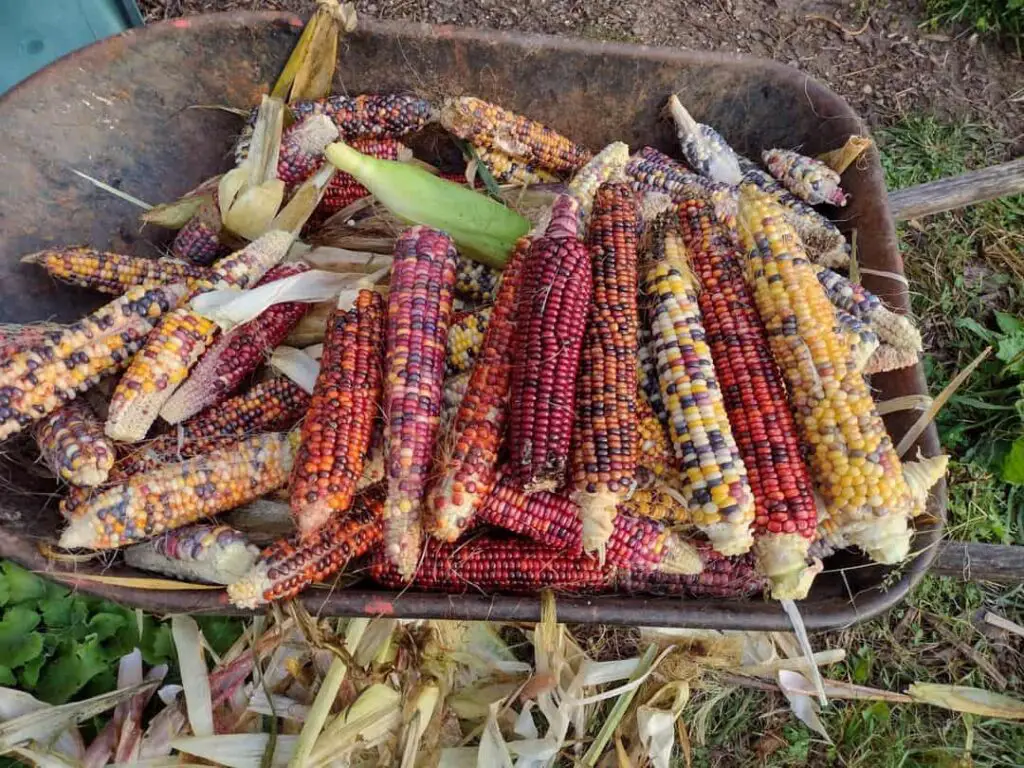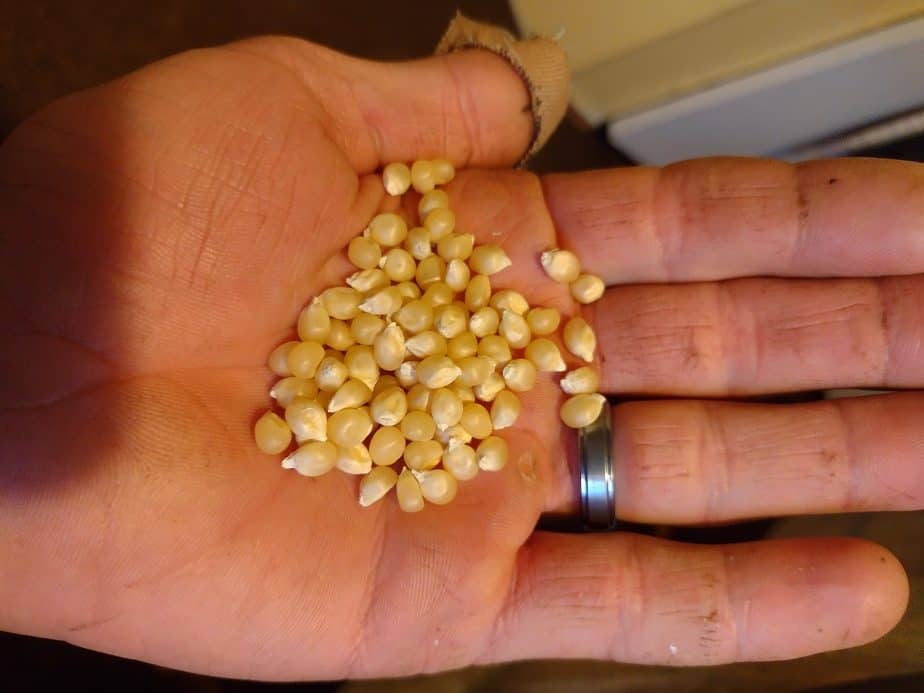We a bit of grow flint corn. It’s my favorite type of corn for cornmeal mush. I’m hoping to plant 1/8th acre of it in a month.
Flint corn is a traditional North American corn well-adapted to cooler weather and developed by ancient peoples over 1,000 years ago. When mature and dry, it has a hard, round, glassy kernel. The kernels have a hard seed coat containing a layer of firm, tightly packed starch.
As amazing as it is, it should be more commonly grown in gardens and easier to find in stores. Flint corn has a unique flavor, nutrition, and growing habits. Let me tell you all about it.

What is Flint Corn Used For?
Flint corn is most commonly popped or used decoratively in the US. Traditionally, it’s roasted and ground into a coarse meal. It also makes a superb freshly ground cornmeal. It is said by some to make the best textured and flavored grits and cornbread.
I just finished processing some flint corn that we grew last year. The variety I grew is called Wade’s Giant Indian. It’s a larger version of the classic-looking Indian corn and boy it’s tasty! Hopefully, it grows well again this year. We generally grind it unroasted. I did try some roasted ones.
The roasted cornmeal wasn’t bad, but I tried using it for grits/cornmeal mush and it was pretty bad. The unroasted stuff made awesome grits though. That’s probably my favorite way to use it. Another way we like it is to roast, or parch, it in a frying pan until it’s good and brown, and eat it like a snack.
Don’t do that if you have bad teeth. It’s tasty and chewable, but still pretty hard. I really do like to grind most of it into meal. I just ground over a gallon. Roast it until the kernels have cracked. Some of mine pop, but not many since it’s not a genuine popcorn variety. Popcorn is flint corn, but not all flint corn is a popcorn.
Tips for grinding flint corn:
Make sure it’s good and dry. If you harvested it yourself, check the dryness by hitting a kernel with a hammer on a hard surface. a properly dry kernel will shatter cleanly like glass. You can use a corn grinder, a heavy-duty spice grinder, or a decent blender. I use My wife’s blender.
Do not use a regular grain/wheat grinder! Most of the electric wheat grinders won’t fit corn through the chute and it can get plugged up inside. Not good.
I dump in a quart of whole corn and set it on high for a minute or until it bogs down. Then I turn over the blender jar and give it a few taps because it tends to get gummed up with the starch. After that, I let it go until it looks good. It can be stored in any way which keeps it dry.
Some old flint corn varieties make excellent popcorn. They usually have popcorn in the name, like Cherokee Longear Popcorn. I am of the opinion that the open-pollinated heirloom varieties tend to taste better, both as a popcorn and a cornmeal.

What Does Flint Corn Taste Like?
Flint corn tastes less starchy and more grainy than regular dent corn. It’s also higher in fiber and protein, and lower in oil.
Modern corn varieties are bred with other concerns than taste, usually yield, and chemical composition (for making by-products). An heirloom variety of any corn tends to have a noticeably fuller grain flavor that readily takes on any flavors or seasonings you put with it.
Although each variety will be a little different, they are all nutritious and delicious. It’s really good as grits/cornmeal mush with cheese and black pepper. That’s by far my favorite way to prepare and eat it.
Flint Corn vs Dent Corn
Flint corn is mostly comprised of hard starch and dent corn has both hard and soft starch. Dent corn’s soft starch is quickly digested but flint corn benefits more from grinding, soaking, or longer cooking times. Flint corn is usually faster growing and better tolerates cool weather.
If you grind it, dent corn makes a meal with a smooth, floury feel to it. That’s because the soft starch is also called floury starch. The starch cells are barely held together and separate easily. It still has some grit to it from the hard starch it contains.
Now, flint corn has zero or almost zero soft starch. It doesn’t really get a floury feel to it after being ground. It’s all grit, which is why it makes better corn grits in my opinion. The hard starch cells are held together and encapsulated by a layer of tough proteins called promalins or zeins.
This is the part (the hard starch) of corn that can pass through digestion without fully breaking down. humans, chickens, and pigs can digest it fairly well, but rumen like cows and goats have a harder time. It either has to be cooked, or fermented.
Flint corn needs to be cooked or fermented to get its full nutrition. Flour corns and dent corns are often fed dry and raw to livestock, and that works okay, but corn with hard starch, like dent and flint, needs a bit of processing. After cooking or fermenting, they are the most nutritious corns.
Proper gut health in rumen will really help them to digest it since food is fermented in their gut. But, pre-fermentation (soaking in water for 24-48 hours) helps a lot. Either proper fermentation or cooking is required to break down the promalins and get full access. Fine grinding only helps a little.
Fermenting corn in water is an old practice, similar to making sourdough bread. You usually just soak grains overnight, but flint corn likes at least 24 hours at room temperature. Less if it’s warmer out. Fermenting grains also increases the protein by 10-20 percent.
My wife cooks oatmeal from overnight fermented oats, and I think we’ve done that with barley too. It is different, but not bad at all. It has a sourdough taste to it. That’s one way to slightly lessen the starch and increase the protein of a grain.
Another big plus for flint corn is its long storage life. The hard starch, since it’s bound and covered by tough promalin proteins, seems to better resist bugs and going stale. At least that’s one of my personal observations. Can’t say it’s thoroughly tested, but I have a strong suspicion it’s so.
Here are some related articles you might like:

